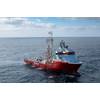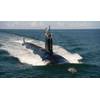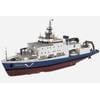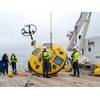Real-time ECDIS Updates via FleetBroadband

L to R: Ronald Spithout, President, Inmarsat Maritime and John Laderos, Chief Executive Officer of SRH Marine SAIT. Image: Inmarsat
A contract signed in London at the end of last month by Inmarsat and SRH Marine SAIT formalizes arrangements for real-time Electronic Chart Display and Information System (ECDIS) updating to be accomplished ‘ship-to-shore’ using an application over FleetBroadband for the first time.
The SRH Delta platform, which includes chart updates, publications and notices of mariners, will be available for L-band transmission to any FleetBroadband user equipped with the new, dedicated bandwidth Application Access Point Name (APN) developed by Inmarsat.
“The SRH platform is the first application by a third-party supplier to use our new FleetBroadband Application APN and in this instance allows ship owners and managers worldwide to update ECDIS charts seamlessly and securely, on demand and without interrupting their primary bandwidth service,” said Ronald Spithout, President, Inmarsat Maritime. “The contract signing followed laboratory tests of the new ECDIS-update application at Inmarsat’s R&D facilities in Ålesund, Norway, and full sea-trials conducted by SRH Marine over a three-month period.”
The APN also provides the platform for FleetBroadband to host other real-time vessel management applications from other third-party suppliers, with Inmarsat planning to roll-out a suite of new applications that can work over the coming months to leverage the benefits of digitalization for the L-Band user.
“This proves that FleetBroadband connectivity, which is available on close to 40,000 vessels, can help support shipping’s transition to digitalisation for mission-critical applications such as ECDIS, and is now a unique enabling platform for applications through the new dedicated bandwidth APN,” said Spithout.
Inmarsat’s investment in L-band for maritime is continuing; its I-6 satellites, the first of which is planned for launch next year, will add both L-band and Ka-band capacity to the network.
L-band services available over the I-6 satellites will support Inmarsat’s fully IMO-approved next generation advanced global safety services – Fleet Safety - and low cost mobile services to Internet of Things (IoT) applications, Spithout said.
John Laderos, Chief Executive of SRH Marine Electronics, said that the combination of FleetBroadband and the SRH Marine ECDIS Digital Services distribution platform would help boost e-navigation worldwide, as well as setting new standards on maritime communications. “This is a straightforward and practical solution for owners seeking to accelerate their e-navigation strategies, allowing data transmission through FleetBroadband connectivity that is already in position around the globe and proven on performance, coverage and reliability,” said Laderos. “For SRH, the agreement addresses this critical aspect of evolving demands in the international marine technology market for high-tech navigation tools and strengthens our commitment to navigate the future.”














 August 2025
August 2025



